High Step-Up Boost-Cuk-Forward Converter with Reduced Switch Voltage Stress and Ripple-Free Input Current
Abstract
:1. Introduction
2. Combined Boost-Cuk-Forward Topology
2.1. Operation Basics
2.2. Voltage Gain
3. Control of the Proposed Converter
3.1. DC–DC Stage
3.2. Grid-Side Stage
4. Simulation Outcomes
5. Experimental Verifications
5.1. Performance of the Proposed Converter
5.2. Efficiency Analysis
6. Conclusions
Author Contributions
Funding
Institutional Review Board Statement
Data Availability Statement
Conflicts of Interest
References
- Son, S.; Montes, O.A.; Junyent-Ferré, A.; Kim, M. High Step-Up Resonant DC/DC Converter with Balanced Capacitor Voltage for Distributed Generation Systems. IEEE Trans. Power Electron. 2019, 34, 4375–4387. [Google Scholar] [CrossRef]
- Poorali, B.; Jazi, H.M.; Adib, E. Improved High Step-Up Z-Source DC–DC Converter with Single Core and ZVT Operation. IEEE Trans. Power Electron. 2018, 33, 9647–9655. [Google Scholar] [CrossRef]
- Hou, S.; Chen, J.; Sun, T.; Bi, X. Multi-input Step-Up Converters Based on the Switched-Diode-Capacitor Voltage Accumulator. IEEE Trans. Power Electron. 2016, 31, 381–393. [Google Scholar] [CrossRef]
- Pervez, I.; Antoniadis, C.; Ghazzai, H.; Massoud, Y. A Centralized Multi-String PV System Control with Multi-Dimensional MPPT Control. In Proceedings of the 2022 IEEE Asia Pacific Conference on Circuits and Systems (APCCAS), Shenzhen, China, 11–13 November 2022; pp. 304–308. [Google Scholar]
- Yagoub, M.A.; Elserougi, A.A.; Abdelhamid, T.H. Assessment of PV String Optimizer Circuit Versus String and Central Inverters During Partial Shading Conditions. In Proceedings of the 2021 22nd International Middle East Power Systems Conference (MEPCON), Assiut, Egypt, 14–16 December 2021; pp. 14–19. [Google Scholar]
- Xiao, H.; Xu, T.; Xiang, L.; Zhang, Z.; Xie, S.; Liu, D. A Variable Phase-Shift Control Scheme for Extended-Duty-Ratio Boost Converter with Automatic Current Sharing in High Step-up High Current Application. IEEE Trans. Ind. Electron. 2021, 68, 6794–6805. [Google Scholar] [CrossRef]
- Lei, H.; Hao, R.; You, X.; Li, F. Nonisolated High Step-Up Soft-Switching DC–DC Converter with Interleaving and Dickson Switched-Capacitor Techniques. IEEE J. Emerg. Selec. Top. Power Electron. 2020, 8, 2007–2021. [Google Scholar] [CrossRef]
- Hassan, W.; Lu, D.D.-C.; Xiao, W. Single-Switch High Step-Up DC–DC Converter with Low and Steady Switch Voltage Stress. IEEE Trans. Ind. Electron. 2019, 66, 9326–9338. [Google Scholar] [CrossRef]
- Abbasi, M.; Lam, J. A Modular SiC-Based Step-Up Converter with Soft-Switching-Assisted Networks and Internally Coupled High-Voltage-Gain Modules for Wind Energy System with a Medium-Voltage DC-Grid. IEEE J. Emerg. Selec. Top. Power Electron. 2019, 7, 798–810. [Google Scholar] [CrossRef]
- Li, X.; Zhang, Y.; Liu, J.; Gao, Y.; Cao, M. A Universal ZVT Design for a Family of Multiphase Interleaved High Step-Up Converters with Minimized Voltage Stress and Wide Operating Range. IEEE Trans. Power Electron. 2021, 36, 13779–13791. [Google Scholar] [CrossRef]
- Liu, J.; Wang, K.; Zheng, Z.; Li, C.; Li, Y. A Dual-Active-Clamp Quasi-Resonant Isolated Boost Converter for PV Integration to Medium-Voltage DC Grids. IEEE J. Emerg. Selec. Top. Power Electron. 2020, 8, 3444–3456. [Google Scholar] [CrossRef]
- Chao, K.-H.; Kuo, Y.-P.; Chen, H.-H. Design and Implementation of a Soft-Switching Converter with High Step-Up Ratio. IEEE Access 2023, 11, 48506–48516. [Google Scholar] [CrossRef]
- Jia, P.; Su, Z.; Shao, T.; Mei, Y. An Isolated High Step-Up Converter Based on the Active Secondary-Side Quasi-Resonant Loops. IEEE Trans. Power Electron. 2022, 37, 659–673. [Google Scholar] [CrossRef]
- Rajabi, A.; Rajaei, A.; Tehrani, V.M.; Dehghanian, P.; Guerrero, J.M.; Khan, B. A Non-Isolated High Step-Up DC-DC Converter Using Voltage Lift Technique: Analysis, Design, and Implementation. IEEE Access 2022, 10, 6338–6347. [Google Scholar] [CrossRef]
- Arshadi, S.A.; Poorali, B.; Adib, E.; Farzanehfard, H. High Step-Up DC–AC Inverter Suitable for AC Module Applications. IEEE Trans. Ind. Electron. 2016, 63, 832–839. [Google Scholar] [CrossRef]
- She, J.-M.; Jou, H.-L.; Wu, J.-C. Novel transformerless grid-connected power converter with negative grounding for photovoltaic generation system. IEEE Trans. Power Electron. 2012, 27, 1818–1829. [Google Scholar]
- Heidari, R.; Adib, E.; Jeong, K.-I.; Ahn, J.-W. Soft-switched Boost-cuk-type High Step-up Converter for Grid-tied with Half-bridge Inverter. IEEE J. Emerg. Selec. Top. Power Electron. 2022, 11, 786–795. [Google Scholar] [CrossRef]
- Nathan, K.; Ghosh, S.; Siwakoti, Y.; Long, T. A New DC-DC Converter for Photovoltaic Systems: Coupled-Inductors Combined Cuk-SEPIC Converter. IEEE Trans. Energy Conv. 2019, 34, 191–201. [Google Scholar] [CrossRef]
- Ferrera, M.B.; Litrán, S.P.; Durán Aranda, E.; Andújar Márquez, J.M. A Converter for Bipolar DC Link Based on SEPIC-Cuk Combination. IEEE Trans. Power Electron. 2015, 30, 6483–6487. [Google Scholar] [CrossRef]
- Tamyurek, B.; Kirimer, B. An Interleaved High-Power Flyback Inverter for Photovoltaic Applications. IEEE Trans. Power Electron. 2015, 30, 3228–3241. [Google Scholar] [CrossRef]
- Zhang, F.; Xie, Y.; Hu, Y.; Chen, G.; Wang, X. A Hybrid Boost–Flyback/Flyback Microinverter for Photovoltaic Applications. IEEE Trans. Ind. Electron. 2020, 67, 308–318. [Google Scholar] [CrossRef]
- Shirmohammadi, S.; Suh, Y. Multiwinding Flyback Clamp Snubber for 10 kV IGCT with Reduced Voltage Stress on Clamp Recovery Diodes. IEEE Trans. Ind. Appl. 2020, 56, 2729–2740. [Google Scholar] [CrossRef]
- Sathyan, S.; Suryawanshi, H.M.; Ballal, M.S.; Shitole, A.B. Soft-Switching DC–DC Converter for Distributed Energy Sources with High Step-Up Voltage Capability. IEEE Trans. Ind. Electron. 2015, 62, 7039–7050. [Google Scholar] [CrossRef]
- Gao, S.; Sang, X.; Wang, Y.; Liu, Y.; Guan, Y.; Xu, D. A DCM High-Frequency High-Step-Up SEPIC-Based Converter with Extended ZVS Range. IEEE J. Emerg. Selec. Top. Power Electron. 2022, 10, 7915–7924. [Google Scholar] [CrossRef]
- Kim, J.-K.; Moon, G.-W. Derivation, Analysis, and Comparison of Nonisolated Single-Switch High Step-up Converters with Low Voltage Stress. IEEE Trans. Power Electron. 2015, 30, 1336–1344. [Google Scholar] [CrossRef]
- Seshagiri, R.V.; Kumaravel, S. Ultra-Voltage Gain Bidirectional DC–DC Converter With Reduced Switch Voltage Stress and Improved Efficiency. IEEE Trans. Circuits Syst. II: Express Briefs 2022, 69, 4468–4472. [Google Scholar]
- Yang, P.; Xu, J.; Zhou, G.; Zhang, S. A new quadratic boost converter with high voltage step-up ratio and reduced voltage stress. In Proceedings of the 7th International Power Electronics and Motion Control Conference, Harbin, China, 2–5 June 2012; pp. 1164–1168. [Google Scholar]
- Zeng, T.; Wu, Z.; He, L. An Interleaved Soft Switching High Step-Up Converter with Low Input Current Ripple and High Efficiency. IEEE Access 2019, 7, 93580–93593. [Google Scholar] [CrossRef]
- Zheng, Y.; Brown, B.; Xie, W.; Li, S.; Smedley, K. High Step-Up DC–DC Converter with Zero Voltage Switching and Low Input Current Ripple. IEEE Trans. Power Electron. 2020, 35, 9416–9429. [Google Scholar] [CrossRef]
- Zaoskoufis, K.; Tatakis, E.C. Isolated ZVS-ZCS DC–DC High Step-Up Converter with Low-Ripple Input Current. IEEE J. Emerg. Selec. Top. Ind. Electron. 2021, 2, 464–480. [Google Scholar] [CrossRef]



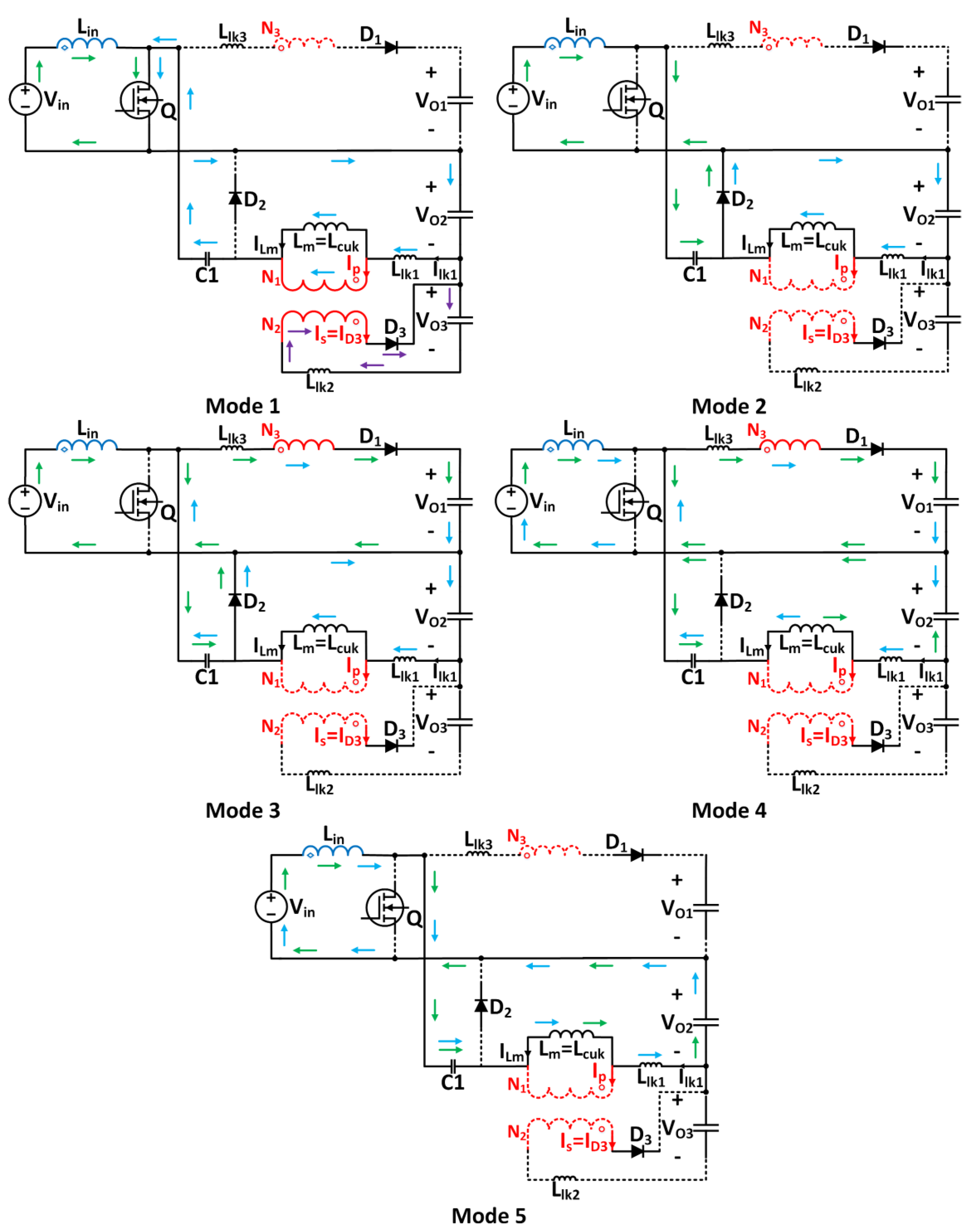


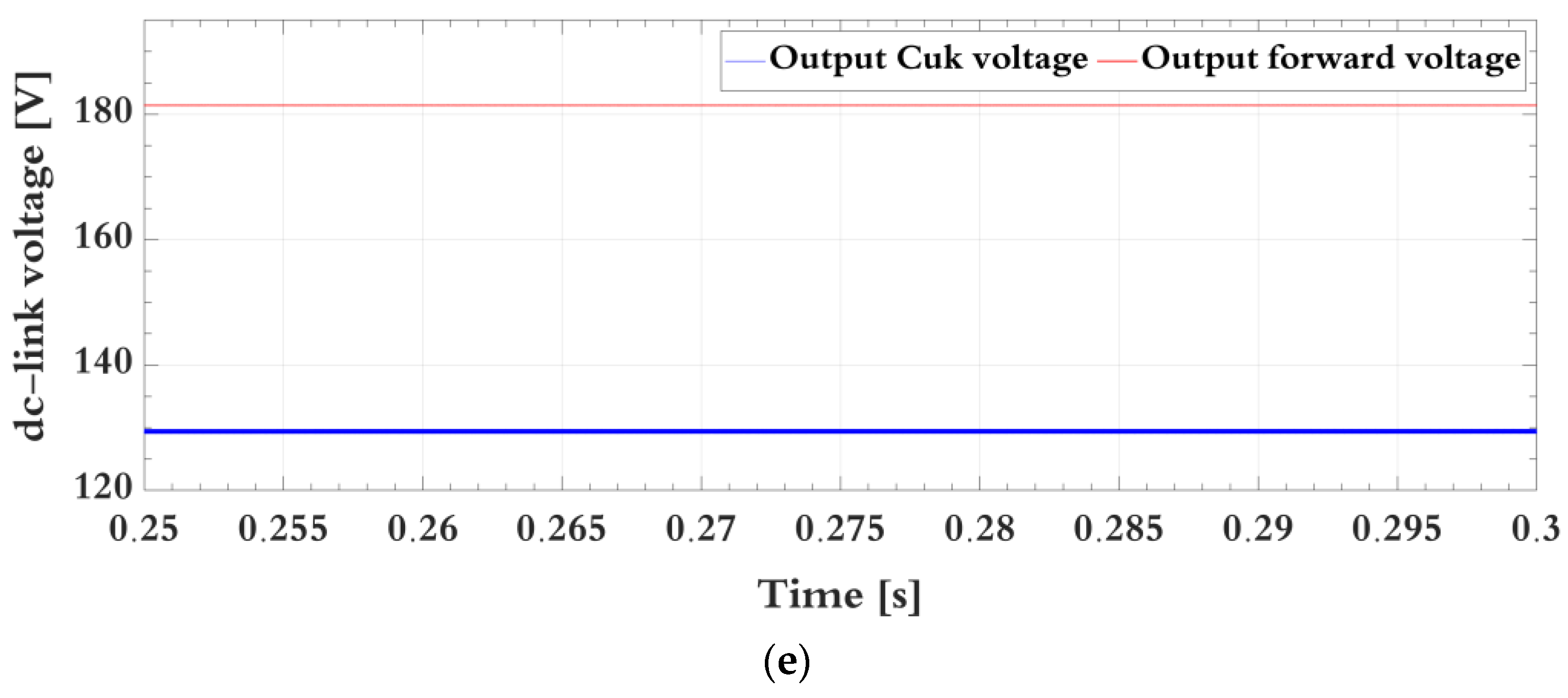
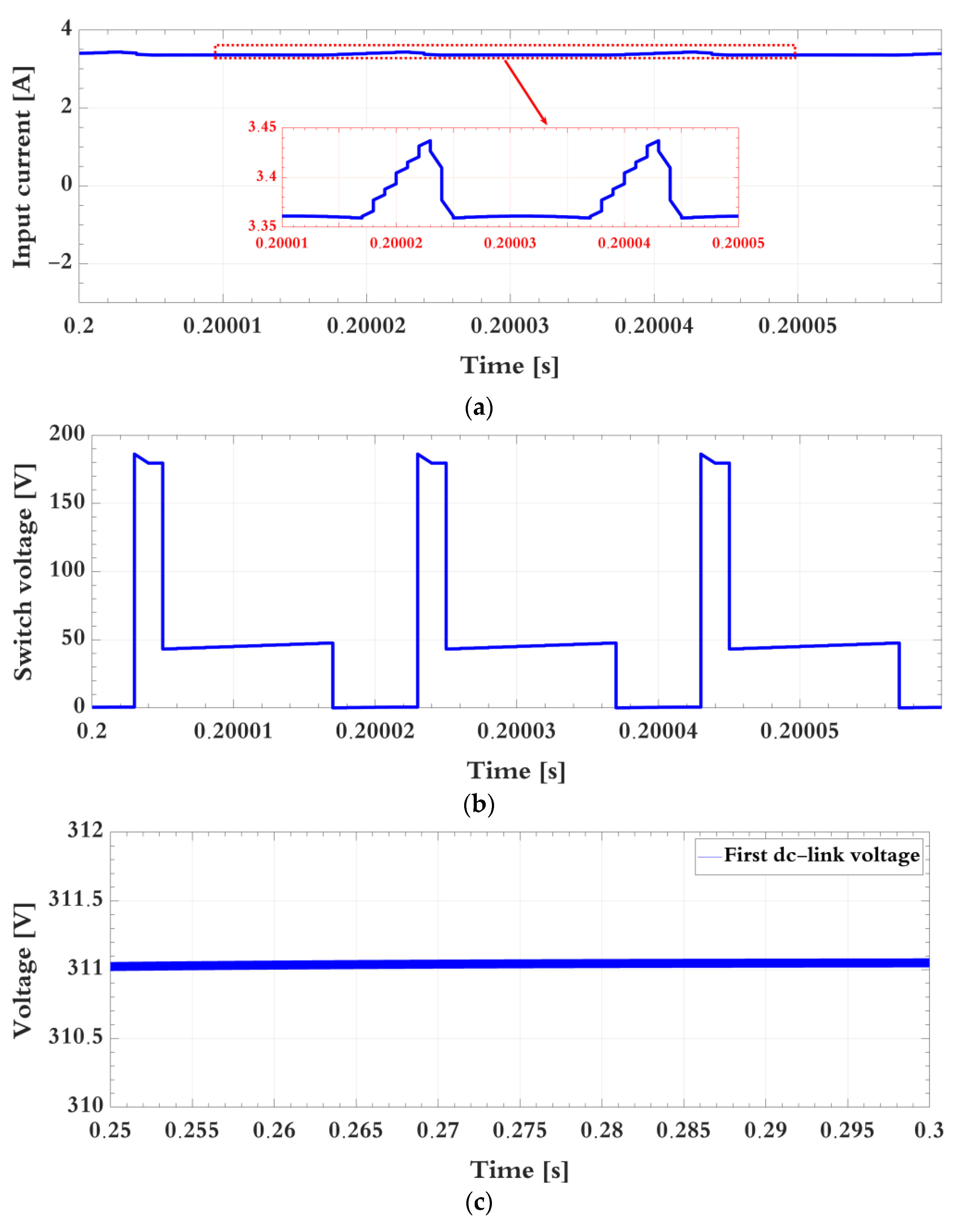
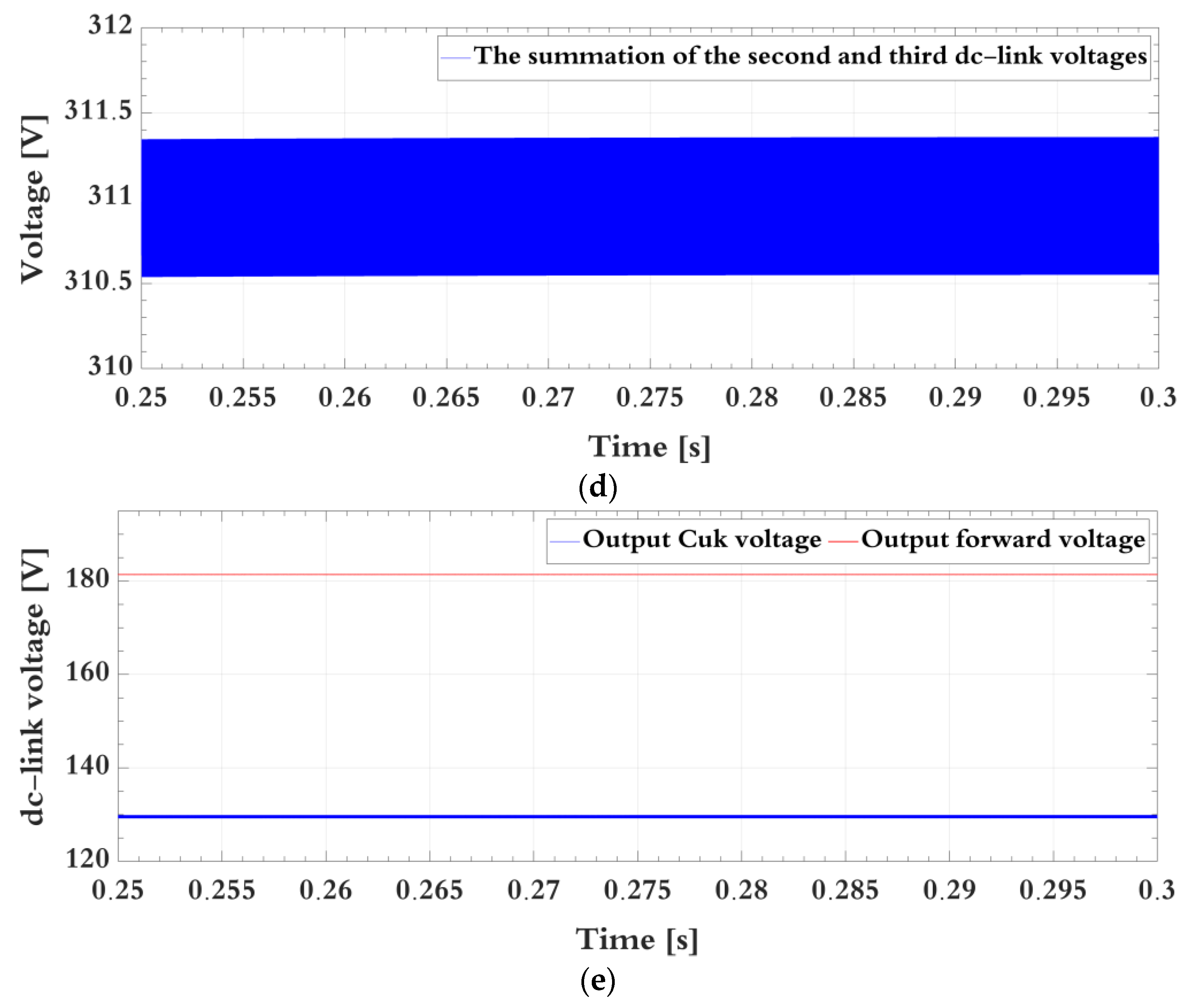
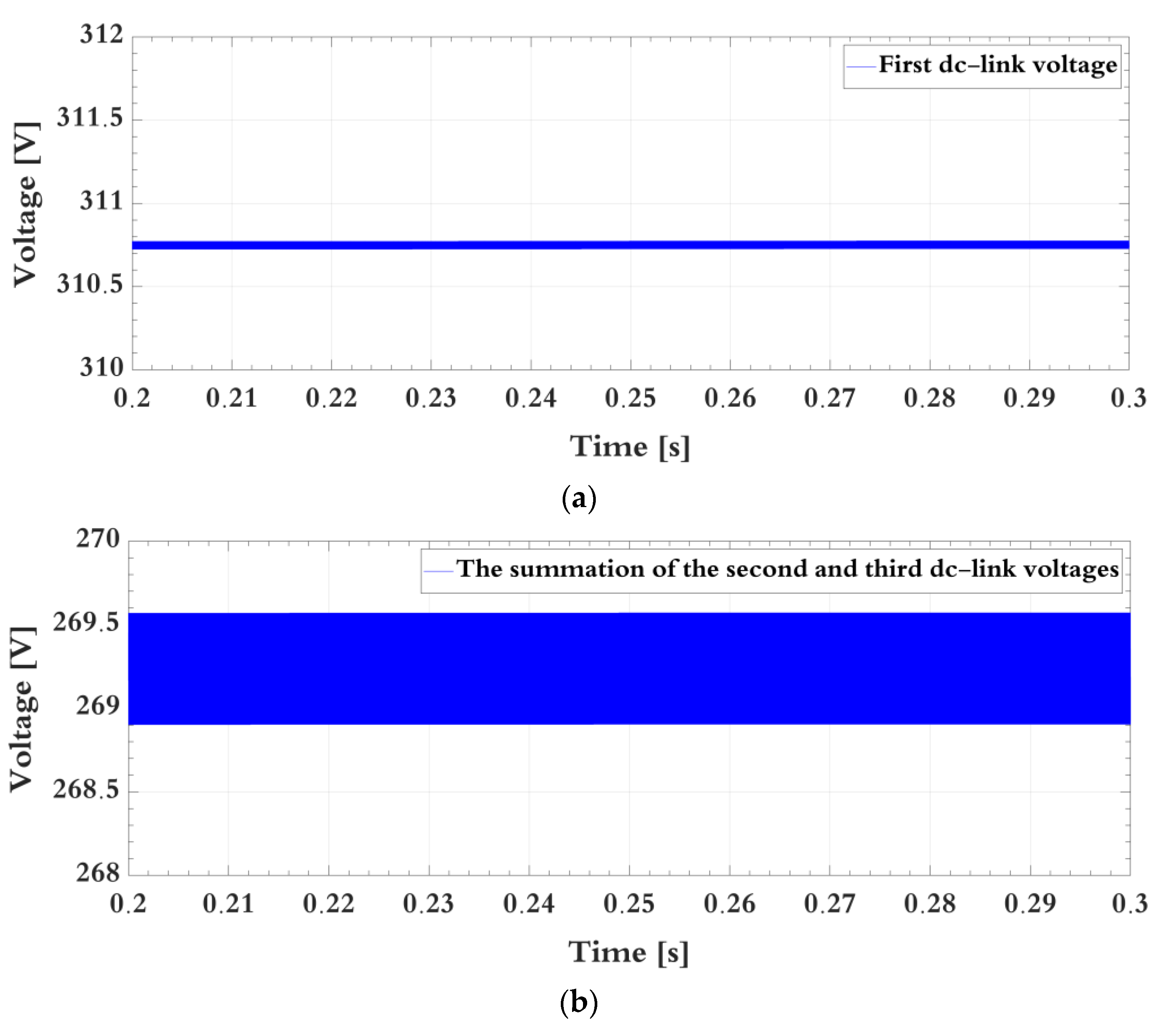
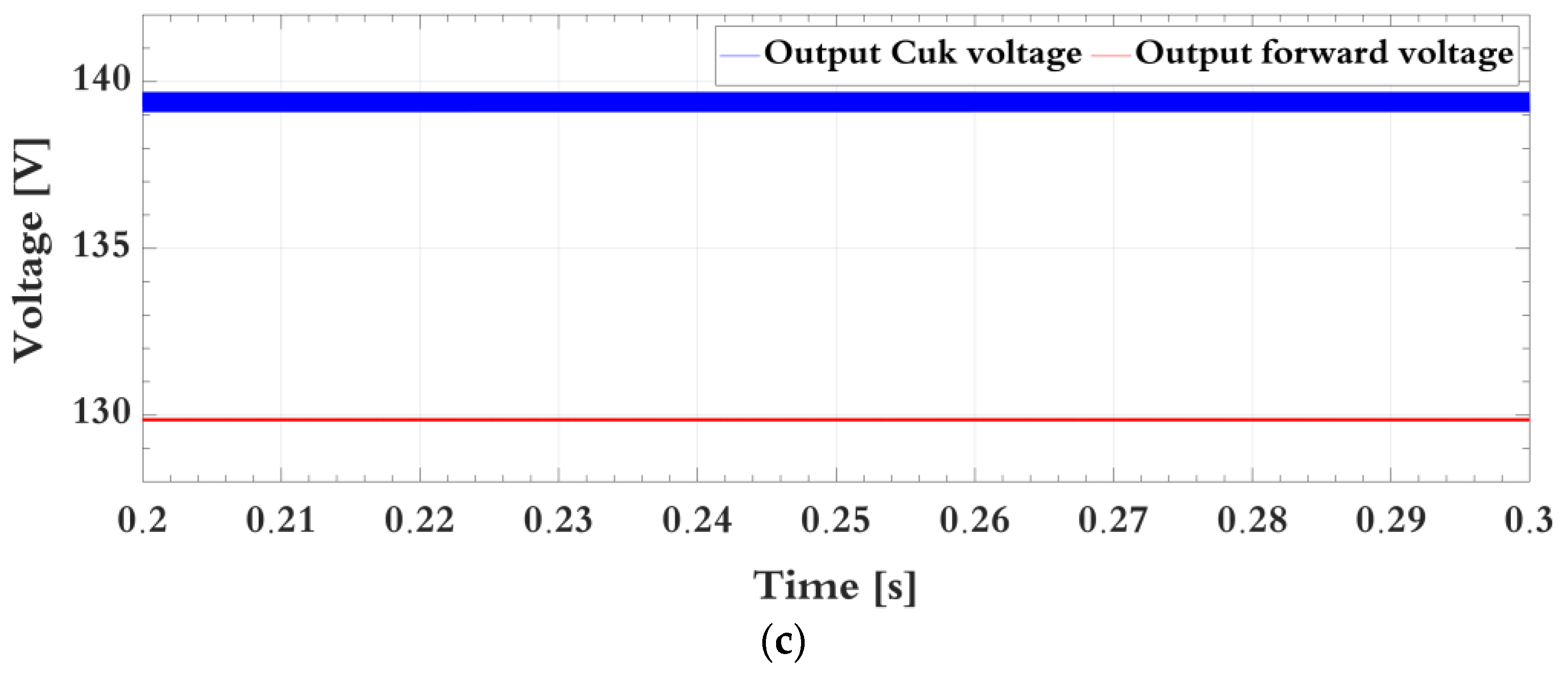

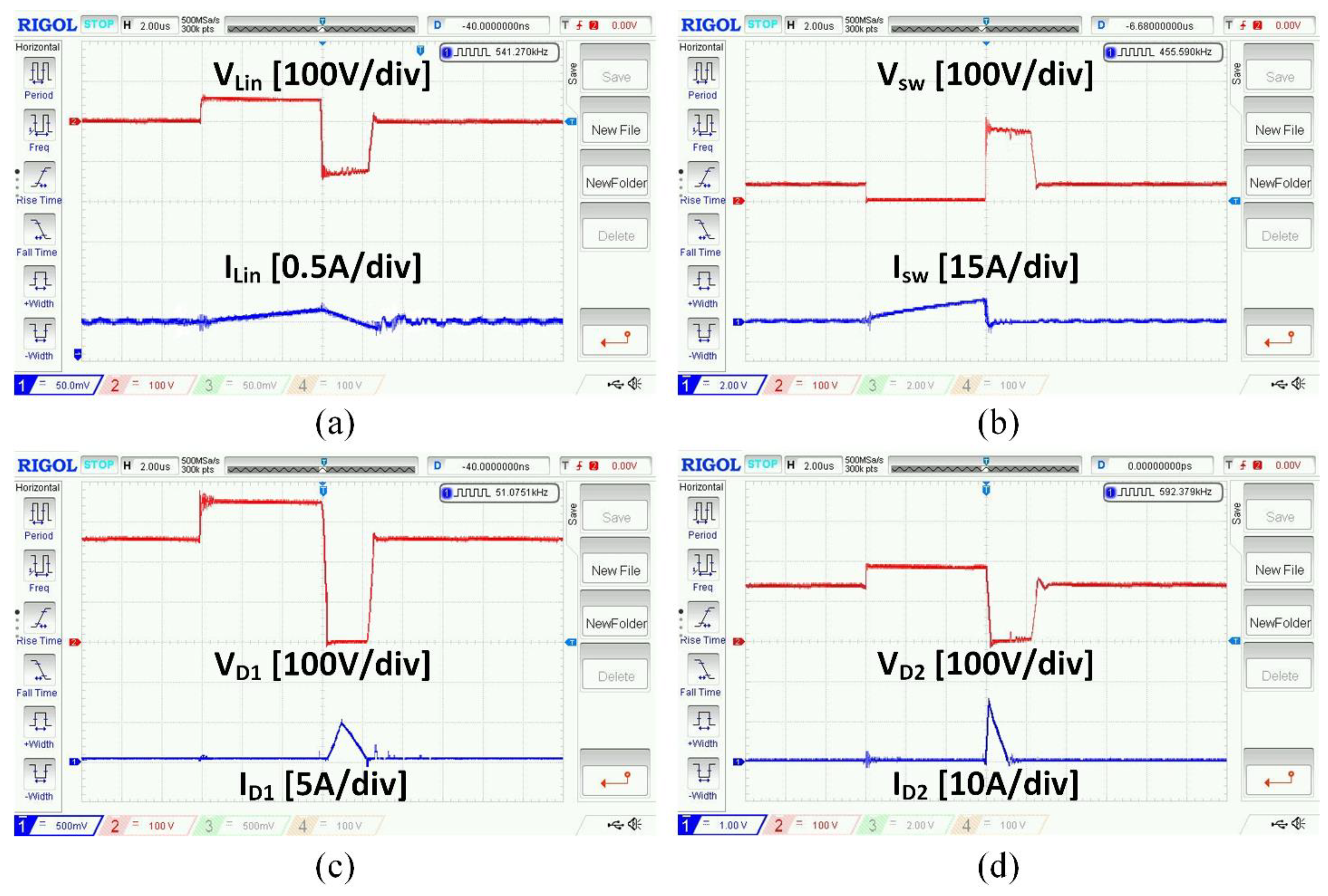

| Signs | Parameters | Value |
|---|---|---|
| PV | Solar module | NA-E130G |
| Voltage at MPP | 45.4 v | |
| Current at MPP | 3.3 A | |
| Grid voltage | 220 Vrms | |
| Grid inductance | 4 mH | |
| Switching frequency | 50 KHz | |
| Input inductance | 800 uH | |
| Cuk inductance | 17 uH | |
| Cuk leakage inductance | 1 uH | |
| Forward leakage inductance | 1 uH | |
| Third leakage inductance | 2 uH | |
| k | Coupling coefficient | 0.96 |
| First turn ratio | 1 | |
| Second turn ratio | 4 | |
| Output capacitor | 66 uF | |
| Q | Main switch | IRFP4668 |
| Boost diode | MUR860 | |
| Cuk diode | MUR860 | |
| Forward diode | UF5408 | |
| Cuk capacitance | 5.6 uF | |
| Grid inductance | 3 mH | |
| & | H-bridge switch | FGL40n120 |
| Elements | Peak Voltage | Peak Current |
|---|---|---|
| Switch Q | ||
| Ref. | No. of Passive Elements | No. of Semiconductors | Switching Condition | Input Current Ripple | MOSFET Stress Voltage | Efficiency |
|---|---|---|---|---|---|---|
| [23] 12 V/120 V | 3 inductors 5 capacitors | 2 switches 2 diodes | Soft | High | High | 91.8% |
| [24] 24 V/250 V | 2 inductors 3 capacitors | 1 switch 3 diodes | Hard | High | Low | 89% |
| [28] 40 V/400 V | 3 inductors 4 capacitors | 2 switches 2 diodes | Soft | Low | High | 94.8% |
| [30] 30 V/200 V | 5 inductors 5 capacitors | 1 switch 4 diodes | Soft | Low | Low | 94.2% |
| Proposed 45 V/622 V | 4 inductors 4 capacitors | 1 switch 3 diodes | Hard | Low | Low | 93.07% |
Disclaimer/Publisher’s Note: The statements, opinions and data contained in all publications are solely those of the individual author(s) and contributor(s) and not of MDPI and/or the editor(s). MDPI and/or the editor(s) disclaim responsibility for any injury to people or property resulting from any ideas, methods, instructions or products referred to in the content. |
© 2023 by the authors. Licensee MDPI, Basel, Switzerland. This article is an open access article distributed under the terms and conditions of the Creative Commons Attribution (CC BY) license (https://creativecommons.org/licenses/by/4.0/).
Share and Cite
Heidari, R.; Ghanbari, M.A.; Adib, E.; Jeong, K.-I.; Ahn, J.-W. High Step-Up Boost-Cuk-Forward Converter with Reduced Switch Voltage Stress and Ripple-Free Input Current. Energies 2023, 16, 6391. https://doi.org/10.3390/en16176391
Heidari R, Ghanbari MA, Adib E, Jeong K-I, Ahn J-W. High Step-Up Boost-Cuk-Forward Converter with Reduced Switch Voltage Stress and Ripple-Free Input Current. Energies. 2023; 16(17):6391. https://doi.org/10.3390/en16176391
Chicago/Turabian StyleHeidari, Reza, Mohammad Ali Ghanbari, Ehsan Adib, Kwang-Il Jeong, and Jin-Woo Ahn. 2023. "High Step-Up Boost-Cuk-Forward Converter with Reduced Switch Voltage Stress and Ripple-Free Input Current" Energies 16, no. 17: 6391. https://doi.org/10.3390/en16176391
APA StyleHeidari, R., Ghanbari, M. A., Adib, E., Jeong, K.-I., & Ahn, J.-W. (2023). High Step-Up Boost-Cuk-Forward Converter with Reduced Switch Voltage Stress and Ripple-Free Input Current. Energies, 16(17), 6391. https://doi.org/10.3390/en16176391









